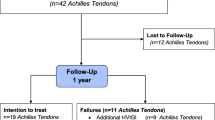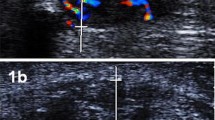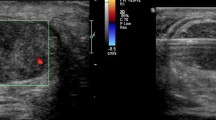Abstract
The short-term results after treatment with sclerosing polidocanol injections have been shown to be good in patients with chronic painful mid-portion Achilles tendinosis. This study aimed to evaluate the longer-term effects on tendon thickness, structure and vascularity, patient satisfaction with treatment, and pain during tendon loading activity. Ultrasonography (US) + colour Doppler (CD) was used for evaluation of the tendon, and the patients graded the amount of pain during tendon loading activity on a VAS. Forty-two patient’s tendons (23 men and 19 women, mean age 53 years) with a long duration (mean 32 months) of pain symptoms from mid-portion Achilles tendinosis (US + CD showed a localised thickening, structural changes and neovascularisation), were at three (mean) occasions (6–8 weeks in between) treated with US and CD guided injections of the sclerosing substance polidocanol, targeting the area with neovessels ventral to the tendon. After treatment, 37 patients were satisfied with the results of the treatment and back to previous (before injury) activity level. At the 2-year follow-up (mean 23 months), 38 patients were satisfied with the results of the treatment, and there was a significant reduction in VAS (from 75 to 7; P < 0.05). US showed a significant reduction in the mean mid-portion tendon thickness (from 10 to 8 mm, P < 0.05) and a “more normal” structure. CD showed no, or a few, remaining neovessels in the majority of the successfully treated tendons. In conclusion, treatment with sclerosing polidocanol injections in patients with chronic painful mid-portion Achilles tendinosis showed remaining good clinical results at a 2-year follow-up. Decreased tendon thickness and improved structure after treatment, might indicate a remodelling potential?

Similar content being viewed by others
References
Józsa L, Kannus P (1997) Human tendons. Anatomy, physiology, and pathology (ISBN 0–87322-484-1) Human Kinetics
Kvist M (1994) Achilles tendon injuries in athletes. Sports Med 18(3):173–201
Movin T (1998) Aspects of aetiology, pathoanatomy and diagnostic methods in chronic mid-portion Achillodynia [dissertation]. Karolinska Institute Stockholm, Stockholm
Alfredson H, Pietilä T, Jonsson P, Lorentzon R (1998) Heavy-loaded eccentric calf-muscle training for the treatment of chronic Achilles tendinosis. Am J Sports Med 26(3):360–366
Alfredson H, Öhberg L (2005) Sclerosing injections to areas of neovascularisation reduce pain in chronic Achilles tendinopathy: a double-blind randomized controlled trial. Knee Surg Sports Traumatol Arthrosc 13:338–344
Öhberg L, Alfredson H (2002) Ultrasound guided sclerosis of neovessels in painful chronic Achilles tendinosis: pilot study of a new treatment. Br J Sports Med 36:173–177
Öhberg L, Lorentzon R, Alfredson H (2001) Neovsacularisation in Achilles tendons with painful tendinosis but not in normal tendons: an ultrasonographic investigation. Knee Surg Sports Traumatol Arthrosc 9:233–238
Bjur D, Alfredson H, Forsgren S (2005) The innervation pattern of the human Achilles tendon—studies on the normal and tendinosis tendon using markers for general, sensory and sympathetic innervations. Cell Tiss Res 320:201–206
Forsgren S, Danielsson P, Alfredson H (2005) Vascular NK-1R receptor occurrence in normal and chronic painful Achilles and patellar tendons. Studies on chemically unfixed as well as fixed specimens. Regul Pept 126:173–181
Conrad P., Malouf GM., Stacey MC (1995) The Australian polidocanol (aethoxysklerol) study. Results at 2 years. Dermatol Surg 21(4):334–336
Guex JJ (1993) Indications for the sclerosing agent polidocanol. J Dermatol Surg Oncol 19(10):959–961
Winter H, Drager E, Sterry W (2000) Sclerotherapy for treatment of hemangiomas. Dermatol Surg 26(2):105–108
Paavola M, Paakkala T, Kannus P et al (1998) Ultrasonography in the differential diagnosis of Achilles tendon injuries and related disorders. Acta Radiol 39:612–19
Åström M, Gentz CF, Nilsson P et al (1996) Imaging in chronic Achilles tendinopathy: a comparison of ultrasonography, magnetic resonance imaging and surgical findings in 27 histologically verified cases. Skeletal Radiol 25:615–20
Terslev L, Qvistgaard E, Torp- Pedersen S, Laetgaard J, Danneskiold- Samsøe B, Bliddal H (2001) Ultrasound and power Doppler findings in jumper’s knee—preliminary Observations. Eur J Ultrasound 13:183–189
Weinberg EP, Adams MJ, Hollenberg GM (1998) Color doppler sonography of patellar tendinosis. Am J Roentgenol 171(3):743–744
Öhberg L, Lorentzon R, Alfredson H (2004) Eccentric training in patients with chronic Achilles tendinosis normalized tendon structure and decreased thickness at follow-up. Br J Sports Med 38:8–11
Alfredson H, Öhberg L. Forsgren S (2003) Is vasculo-neural ingrowth the cause of pain in chronic Achilles tendinosis?—an investigation using ultrasonography and colour doppler, immunohistochemistry, and diagnostic injections. Knee Surg Sports Traumatol Arthrosc 11:334–338
Acknowledgments
Financial support was obtained from the Swedish National Centre for Research in Sports.
Author information
Authors and Affiliations
Corresponding author
Rights and permissions
About this article
Cite this article
Lind, B., Öhberg, L. & Alfredson, H. Sclerosing polidocanol injections in mid-portion Achilles tendinosis: remaining good clinical results and decreased tendon thickness at 2-year follow-up. Knee Surg Sports Traumatol Arthrosc 14, 1327–1332 (2006). https://doi.org/10.1007/s00167-006-0161-3
Received:
Accepted:
Published:
Issue Date:
DOI: https://doi.org/10.1007/s00167-006-0161-3




